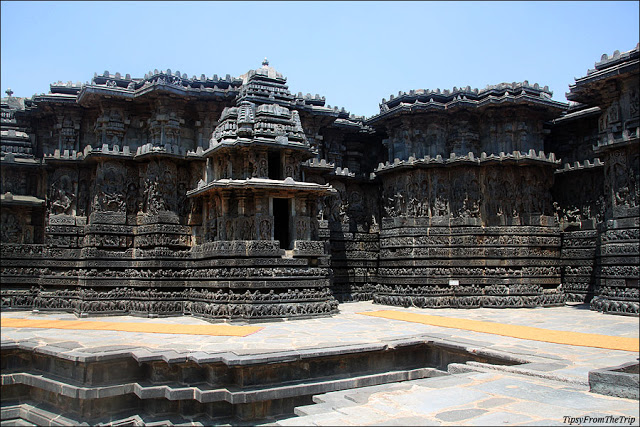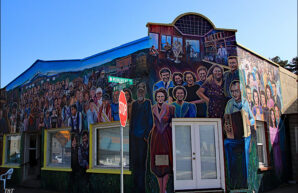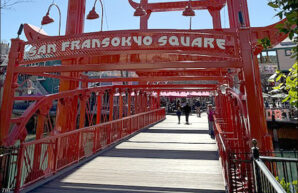Karnataka tells the tales of its rich past between the 12th and 15th centuries through some highly ornate temples that have ‘Hoysala’ writ all over them.
When the Hoysala rulers went about building temples all over what is Karnataka today, they invested in structures that inspire awe with their precisely sculpted walls, intricately chiseled pillars and expertly carved vimanas. They stand out because of the features that are unique to the temple architecture of their times and also the perfection with which the sculpting was done.
Earlier this year, we visited Hoysaleshwara Temple in Halebidu, which used to be the seat of power of the Hoysalas. We also treated ourselves to the brilliant Chennakesava temple in Belur, nearby. These temples in Hassan District are superfine examples of the Hoysala style of temple architecture. They are also proof of the attention to detail that seems to have been a hallmark of the time.
Now, if I see a temple on a star-shaped base, or a stone building wrapped in friezes, or even decked up ‘bracket figures’ and stone-latticed facades, I’ll know that it is a specimen of the architectural legacy of the Hoysalas.
Here in this post, let me let some pictures and cut-lines take you through this sculptural ensemble better known as Hoysaleshwara temple in Halebidu (And then I’ll take you inside the incredible Hoysala temple in Belur, in another post):
Features of the Hoysala style of temple-architecture
 |
Hoysaleshwara temple in Halebidu, a fine example of the Hoysala Dynasty’s temple architecture.
This temple is a work of art in soapstone. |
 |
| The star-shaped base that Hoysala temples are built on is one of the major features of the Hoysala style of architecture. |
 |
| These temples seem to have smaller shrines on the outside. |
 |
Look at Hoysaleshwara temple’s grand stone ‘torana.’
The torana is an overhead decoration that is placed at the doorway. |
 |
Richly ornamented Dwarapalakas or door-keepers of the temple.
Don’t miss the details in the jewellery that they have been adorned with. |
 |
| Stone lattice work to let air and light into the mantapa where the devotees gather. |
 |
| Lathe -turned pillars are another noted feature of Hoysala temple. |
 |
| Even the ceilings were treated with ornate work. In the picture is a mantapa ceiling of Hoysaleshwara temple. |
 |
Bracket figures.
Another characteristic feature of Hoyala’s temple architecture. These figures are attractions by themselves. |
 |
| This is a pillared hallway that connects the two shrines within this stone structure. |
 |
| The Nandi(s) (the bull that was lord Shiva’s vehicle) that face the temple entrances. |
 |
| An open mantapa (on the right) |
 |
| Garuda Pillar, A Shivling (phallic representation of lord Shiva); and Ganapati in the temple premises. |
Now that you’ve had a photo tour of the Hoysaleshwara temple, don’t you think you too can identify a Hoysala temple? 😉
PS: This temple still functions as a place of worship. (It is open to visitors too.)
Also visit:
And marvel at the beauty of —
Linking to
Come, Trip with us. 😉
































Beautiful photos.
Thank you, Lotusleaf.
beautiful pictures .. thank you for sharing 🙂
Bikram's
Thank you Bikram. The pleasure is mine. I was so amazed by the work on stone. I had to take pictures. I had to share it. 🙂
yesssssss and lucky us also got to see it all 🙂
I know… lucky you. 😉
And lucky me for having readers like you, Bik. 🙂
Nice photos
Thank you, Rupam.
Hoysala temples are some of the most ornate and intricately carved temples, your pictures truly bring out there architectural and artistic grandeur and is sure a comprehensive guide on them…I visited a Hoysala temple on way to Chikamagaluru in July , looking forward to your post about Belur temple I had no idea how intricately carved the temple is and I left my camera in the car and only had cell phone to click pictures…:(
They really are, Prasad. I'd seen many pictures of these temples. But seeing it in person was a whole different thing; that was when I saw the smaller details. I was glad I went and saw it. It was an 'experience.'
I'm can guess how it felt not having your camera on you when you found that the sculpture was grander than you expected. I couldn't stop taking pictures. 😀 There's always a next time.
Or maybe you could do Belur – Halebidu next. My suggestion — see Halebidu first and then Belur. You'll see why, when you visit. 😉
Very Nice information .very awesome photography . Thanks for your sharing .
Thank you so much.
Thank you for visiting this blog. 🙂
The temples of Haleibid and Belur are absolutely marvelous. Love the Hoysala architecture. You have captured them beautifully, Divya!
Marvellous indeed. The sculptures and the craftsmanship went beyond my expectations. And learning a little something about Hoysala architecture made me appreciate it more.
Thank you so much, Nomad. 🙂 I was just telling Prasad, I couldn't stop taking pictures. 🙂
I have seen these temples. They are marvellous. Thanks for reigniting those memories.
Absolutely!!
They seemed like wonders on stone. You're welcome, Rachna.
Thank you for coming by. 🙂
I wonder how they managed such perfect lathe turned pillars.
Nice pics.
To me the lathe turned pillars seem like the easier and smarter jobs they did. What I am amazed by is the chisel work and the finer details on the figures — like the jewellery and all.
Thank you so much Haddock. The work on the temples is so awe-inspiring.
For a change, have seen this place, but could not capture the details in camera like you , Divya:)
🙂
Aren't the details on the sculptures incredible?!
I'm glad I took lots of pictures, now I can look at them every now and then and fill myself with awe. 🙂
Thank you for coming by, Mr. Bhatia.
A wonderful post on classic architecture!
Classic indeed.
Thank you, Magic eye. 🙂
Beautiful photographs.
http://thetalesofatraveler.com/2015/10/16/the-best-time-to-visit-thailand/
Thank you, Swati/Sam.
Beautiful captures dear. Quite an aesthetically appealing architecture 🙂
Thank you Maitreni. The architecture and the sculpture were almost unbelievable. 🙂
Beautiful pictures.The style is distinctive – particularly the pillars and ornamental work, Hampi is also an example of Hoyasala architecture. Right?
Thank you, Somali.
Yeah, very distinctive in style. Earlier I only knew that it was richly sculpted. I'm glad I can recognise this style of architecture, now. 😉
Hampi, I believe is in the Vijaynagar style. There's a temple some 120 kms away from Bangalore that I visited earlier this year that was also in Vijaynagar style — Lepakshi. That one had some impressive pillars too. 🙂
This is one amazing monument! I was on a clicking spree when I visited the place. the guides there seemed knowledgeable too.
The signature elements that you mentioned does help identify the architecture style.
Amazing it is. I never thought I'd be that affected by the work. In places like this, it is always better for us to take the service of guides, really.
Yeah, I think the features are very distinctive and they make the style very unique.
Beautiful photos…
Thank you.
These beautiful pictures have truly captured the essence and simplicity of the temples! Love the detailed stone architecture! Thanks for sharing X
http://www.yellow-postcard.com
Thanks a ton, Aditi. Nice to hear that.
Welcome here.
Yellow postcard? That sounds very inviting. I'm going to be checking out your blog, soon. 🙂
Lovely architecture temple.Nice shots Divya.Had been to the temple 5 years back.But the architecture work still lingers in our mind.
You can also see our post on this.
http://www.srikri.com/2010/12/belur-and-halebidu-900-year-old-hoysala.html
Cheers,
Sriram & Krithiga
Yeah, this is a very impressive place also the temple in Belur.
Thank you for the link — I'll come by and read the post.
Thanks guys.:)
Lovely shots of the temple, a nice tour… I am glad you are able to appreciate the architecture and recognize the worth of that civilization belonging to Indian history(: …. its all a great work of art and craftsmanship and how many ever eras pass these stand out like classics… I have heard about all this in history books was good to see them around here…
First of all, welcome here, Amanda.
Yeah, India is very rich in culture, art and architecture. These subjects are very vast. I'm glad I found a guide to take me through the main features and some history of the Hoysalas. It is such a pleasure to share what I learned while I was at these ancient site. 🙂
[…] Hoysaleshwara temple – A signature of the Hoysala dynasty […]
[…] far from Halebidu — the capital city of the Hoysalas — is a symbol of the dynasty’s victory over […]